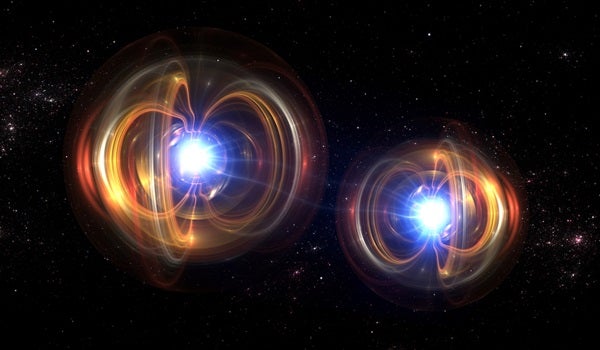
(This article was originally published in the May 2022 issue of Astronomy).
St. Augustine said of time, “If no one asks me, I know what it is. If I wish to explain to him who asks, I don’t know.” Time is an elusive concept: We all experience it, and yet, the challenge of defining it has tested philosophers and scientists for millennia.
It wasn’t until Albert Einstein that we developed a more sophisticated mathematical understanding of time and space that allowed physicists to probe deeper into the connections between them. In their endeavors, physicists also discovered that seeking the origin of time forces us to confront the origins of the universe itself.
What exactly is time, and how did it come into being? Did the dimension of time exist from the moment of the Big Bang, or did time emerge as the universe evolved? Recent theories about the quantum nature of gravity provide some unique and fantastic answers to these millennia-old questions.
Our sense of time
Everything you think you know about time comes largely from your internal experience of it. In terms of how your brain experiences the world, only the immediate present exists, and it encompasses only about one second.
We call this the present, but technically, it is called the experience of now by psychologists, philosophers, physicists, and brain researchers. Your brain generates your sense of the past through its stored memories and your sense of the future from predictions that it makes about what will happen in the next few seconds, minutes, or hours. The flow of time is an illusion based on a succession of immediate memories, your experience of now, and a succession of events you anticipate in the coming seconds. A century of accumulated knowledge from stroke victims and neurophysiological pathologies has also revealed the many brain systems — such as our prefrontal cortex, basal ganglia, and anterior insular cortex — that must work together to provide us with a sense of time.
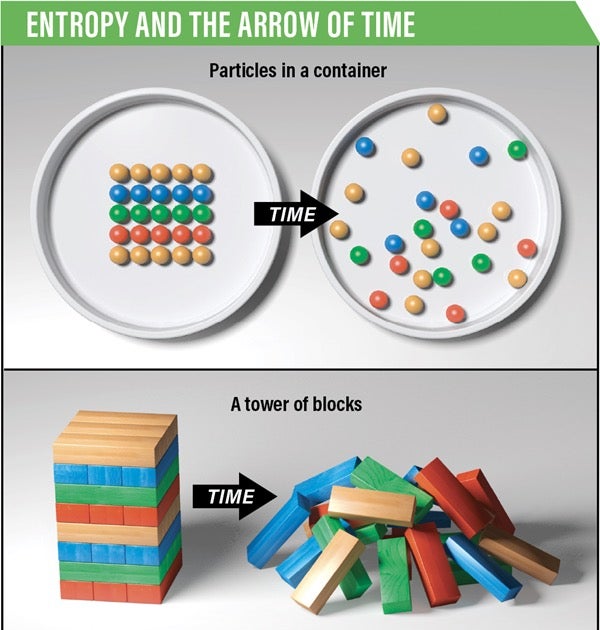
We infer from past memories and our sense of how the physical world behaves that our past did indeed occur; it is not a random hallucination of unrelated snapshots. And objects exist that can corroborate aspects of this story: diaries, photographs, video records, documents, even archaeological relics and fossils. Many of these records can be dated with independent techniques, reinforcing a self-consistent historical story.
But why do we remember the past and not the future? The reason for this asymmetry has to do with entropy — the amount of disorder in the universe. We have memories and historical records only because entropy in the past was lower than the entropy of the present.
Our world features an arrow of time where entropy increases with time. This accords with our sense of time as a one-way street, from past order to future disorder. Yet, there is no basis for the arrow of time in microscopic physics — the realm of quantum mechanics. Those equations are just as valid when time runs in reverse. Therefore, some scientists think the arrow of time exists because the universe must have started out in an incredibly orderly and unlikely state. This is called the Past Hypothesis.
The Order of Time
As systems evolve, their possible states increase as the amount of space for their states to occupy grows. Therefore, entropy increases in the universe in the same direction in time that the universe is expanding, which we experience as the arrow of time. All of our subjective experiences take place against this backdrop. In his book The Order of Time, physicist Carlo Rovelli at Aix-Marseille University in France notes, “In order to leave a trace, it is necessary for something to become arrested, to stop moving, and this can happen only in an irreversible process — that is to say, by degrading energy into heat.” This is true when meteorites leave their impact on the ground and liberate heat, and for computer hard drives, which heat up when data is written to them. It also occurs in your brain: As Rovelli notes, every memory you have was created because it takes energy to create a memory pathway, and this recording of information both heats your brain and increases its entropy.
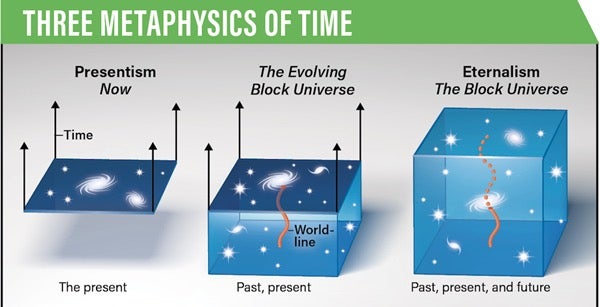
Credit: Astronomy: Roen Kelly, after Steven Savitt
Time and space time
Of course, scientists want to understand how we experience time in mathematical terms that can be tested through experiments. In relativity, the three dimensions of physical space are combined with the one dimension of time into a four-dimensional space-time. The basic elements of space-time are events and worldlines. Events are points within four-dimensional space-time at which some physical interaction or phenomenon takes place, such as two particles colliding or a particle emitting a photon. Worldlines are the paths objects trace through space-time along a sequence of events.
Mathematically, we work with space-time as a four-dimensional continuum: Between any two four-dimensional points, there are an infinite number of additional points. This is a convenient approximation, but it does not represent physical space-time. There are not an infinite number of real, physical events, and so most of the mathematical points are devoid of anything physical.
This means that what we call 3D space is an illusion filled with ghostly, empty points that are not connected to anything in our real world. Einstein expressed this idea when he said, “Time and space are modes in which we think and not conditions in which we live.”
As physicist Lee Smolin of the Perimeter Institute for Theoretical Physics in Waterloo, Ontario, notes in his book Three Roads to Quantum Gravity, the world around us “is nothing but a network of evolving relationships. These relationships are not among things situated in space — they are among the events that make up the history of the world. The relationships define the space — not the other way around.”
Relativity offers at least two views of the nature of objective reality. In one, space-time is a “block” in which the worldlines of all objects exist in their entirety. This view is called eternalism. Past, present, and future events all exist together in this so-called Block Universe, and every event is equally real. Our inability to perceive future events is an illusion. As the physicist Hermann Weyl wrote in his book Philosophy of Mathematics and Natural Science, “The objective world simply is. It does not happen. Only to the gaze of my consciousness crawling upward along the worldline of my body, does a section of the world come to life as a fleeting image of space which continuously changes in time.”
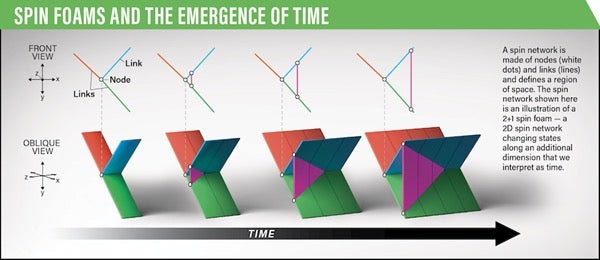
The Block Universe is a delight to time-travel enthusiasts because it says that past events still exist, and we could revisit them if we had the right technology. On the other hand, if the worldlines of every atom in your body, every electron in its orbit, and every neurotransmitter on its way to a synapse are already defined, there can be no free will.
A contrasting idea is presentism, in which the past and future do not exist and only the present has any physicality. Presentism is in far greater accord with our sense that the past is ended, the present is immediate, and the future is open and affords us some free will to choose our specific futures.
The Crystallizing Block Universe
Physicist George Ellis of the University of Cape Town in South Africa and Tony Rothman of Princeton University offered an interesting combination of the ideas in 2009. They called it the Crystallizing Block Universe: The past of the current moment is fixed and stored via memories and records — in some cases, literally etched in stone. The future of the current moment is a cloud of probabilities that is determined by the laws of quantum mechanics. What we call the present is the boundary between these two regimes, where the indeterminacy of the future is crystallizing into the certainty of the past. Humans ride this boundary of crystallization through their perception of their individual nows.
This puts an end to the idea of time travel. In this view, the past exists, but as a collection of information resembling a hologram. For someone to travel into the past and encounter some object (a rock, their grandfather, etc.), they must do so along a worldline that intersects the past object. But all the worldlines constituting the object’s history are already part of our past universe. Since the hypothetical time traveler’s atoms and their worldlines are not a part of that known past record captured in the hologram, the time travel event did not occur! To travel into the past would be like trying to step into a hologram or embed yourself in a family photograph. The best we can do is gather all the records encoded in 3D space about a specific event or object to give us a clearer view of the past.
These discussions provide us with a way of thinking about time on the quantum, human, and cosmic scales, but do not bring us closer to the essential mystery of why space-time contains three dimensions that are purely spacelike and exactly one dimension that is purely timelike. For this, we must understand that, through general relativity, space-time is just another way of describing the gravitational field that surrounds us. And this field, like all others, is probably subject to quantum mechanics.
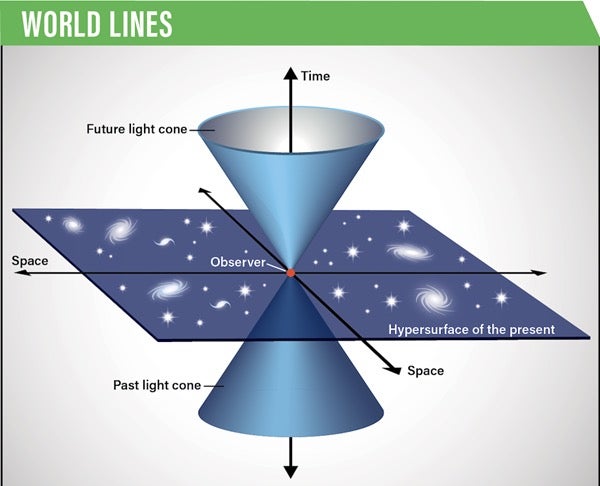
Astronomy: Roen Kelly
Quantum gravity
The Standard Model is our fundamental theory of how three of the forces of nature — electromagnetism and the strong and weak forces — operate on a collection of 12 different matter particles (and their antimatter twins). This model describes quantum fields that exchange particles that mediate forces (bosons) between matter particles (fermions) and produce complex structures such as atoms.
The Standard Model is so successful that experiments at the Large Hadron Collider at CERN, operating at energies up to 14,000 GeV, have been unable to find any significant deviations from calculated predictions. But we know that the Standard Model is incomplete because it has no room for several phenomena we observe. These are dark matter, the invisible stuff that glues galaxies together; dark energy, the mysterious repulsive energy driving the ever-faster expansion of the universe; and any mechanism to explain either cosmological inflation, the exponential expansion of the universe in its early stages, or the fact that we live in a universe dominated by matter instead of equal amounts of matter and antimatter.
The Standard Model also has no explanation for gravity, the fourth fundamental force. That’s because gravity — in the guise of space-time — actually provides the 4-dimensional coordinate basis for all of the Standard Model fields. Ultimately, we need a quantum theory of gravity that leads to a space-time that looks like ours as described by general relativity, but at the same time explains how the Standard Model arose. The theory should also explain dark matter, dark energy, inflation, and the abundance of matter over antimatter, just for starters.
String theory, developed in the 1980s by John Schwartz at Caltech, Michael Green at Queen Mary University of London, and others, is one attempt. It describes the particles and fields of the Standard Model as 1D loops of energy that move and vibrate in an 11-dimensional space-time. The problem is that string theory depends on the pre-existence of a flat four-dimensional space-time through which the strings move. This means gravitons — the hypothetical particles that transmit the force of gravity — can only interact very weakly with space-time. String theory cannot yet derive the existence of space-time itself from the quantum comings-and-goings of gravitons. It also has no ability to provide insight as to the nature of time.
For this, we must look beyond string theory. One such possibility that has generated a lot of interest in the last 30 years is called loop quantum gravity (LQG).
Developed in the 1990s by Smolin and Rovelli, among others, LQG proposes that space consists of objects called nodes that have Planck-scale volumes of 10-99 cm3 — the smallest scale that physics can account for. These nodes define where three-dimensional space exists. The nodes are connected to each other by links, like a set of Tinkertoys. Networks of these nodes and links are called spin networks. But spin networks can be altered in sequences that add and subtract links and nodes. These changes form a 4-dimensional network called a spin foam. (For more on string theory and LQG, see “Imagining our infant universe” in the April 2022 issue.)
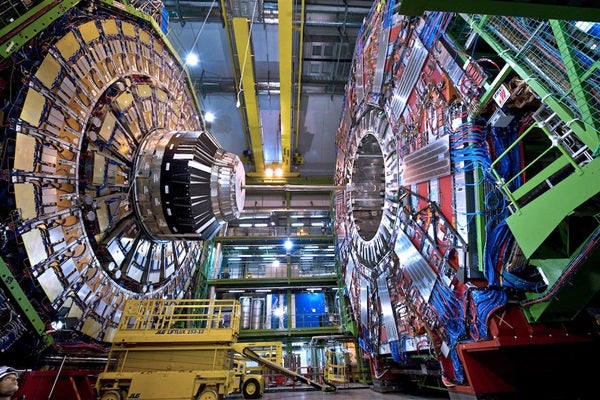
This spin foam is a 3+1-dimensional structure, where the 1 represents the direction along which the changes between spin networks occur. What is remarkable about spin foams is that although they seem to be purely spatial, a phenomenon that we recognize as time emerges from the successive changes in these networks.
The justification for interpreting this axis of change as time has to do with one of the most important features of relativity, called causality. This principle holds that effects must come after their causes in space-time, which allows us to connect events together in a logical timeline.
Think about a drawing of your family tree. The lines you draw between your grandparents, your parents, and yourself are meant to be indications of cause and effect, not physical lines in space. But they do form a very crude timeline. Similarly, causality lets us assign changes in a spin foam to sequences that we interpret as space unfolding over time.
Embedded in each spin network is a small collection of nodes and links that can serve as a clock for that network — like a timestamp in a photograph. But just as a timestamp does not exist outside of a photograph, the concept of time can only exist within the spin networks.
The emergence of time
This idea that time is an emergent phenomenon from within our space-time and not present outside of it was proposed in 1983 by physicists Don Page of the University of Alberta in Edmonton and William Wootters of Williams College in Williamstown, Massachusetts. It was a dramatic solution to the origin of time, placing its source in a phenomenon called quantum entanglement.
In quantum mechanics, two particles are entangled if they interact with each other in such a way that their quantum states can no longer be described independently: That is, if you measure the quantum state of one particle, causing its fuzzy cloud of possible states to collapse to one single state, you can immediately deduce the quantum state of its partner particle. The wave function of the partner particle also collapses instantly, even if it has since zipped off to the other side of the universe. Einstein hated this because it violates the principle of causality in relativity — another way in which quantum mechanics and relativity don’t mix.
But Page and Wootters suggested that an entangled system could give rise to the phenomenon of time — and recently, scientists have begun to test this hypothesis in the lab. In 2013, experiments led by physicist Ekaterina Moreva at the Istituto Nazionale di Ricerca Metrologica in Torino, Italy, showed that the emergence of time occurs in a system of two entangled photons. If an observer uses one photon as a reference clock — or timestamp — to observe its entangled partner, the system appears to evolve in time. But to an observer comparing the entangled photons to the rest of the universe, the system remains static. This means time only emerges for observers within the universe — there can be no “outside the universe” clock where time exists.
Related to this idea of quantum entanglement is the no-boundary proposal for the origin of the Big Bang, developed by James Hartle at the University of California, Santa Barbara, and the late Stephen Hawking, as well as independently by Alexander Vilenkin at Tufts University. In 1983, they proposed that one of the universe’s four spacelike dimensions underwent quantum mechanical tunneling into a timelike dimension at the Big Bang. This triggered what Vilenkin calls “eternal inflation.” Although the universe initially was made of pure space in many dimensions, once one dimension emerged as the direction of a past-to-future succession of states, the Big Bang occurred. This triggered the progression of the universe in the direction of increasing entropy, defining the arrow of time — a critical transition. According to Smolin, without it there could be no coherent 3+1 space-time, but simply a random collection of 4D spacelike spin foams that do not lead to our physical space-time.
The bottom line
Our experience of time may be subjective and limited to a sense of now, but on the cosmic scale, time seems to be a feature of entangled relationships between objects and not a feature from outside our universe. The arrow of time is a consequence of the increasing entropy of an expanding universe since the Big Bang. It appears this precludes us from remembering the future. But at least we have our memories, courtesy of the steady march of entropy, which allows us to recover past events and stitch them into a consistent story. Lucky for us, our universe seems to have a consistent story to tell in the first place!
Dr. Sten Odenwald is an astronomer and educator with the NASA Heliophysics Education Consortium, who also runs an online resource called The Astronomy Cafe. He received his PhD in astrophysics from Harvard University in 1982.
He is an active science popularizer and book author, and has a number of websites promoting science education and mathematics: The Astronomy Café and SpaceMath@NASA. He has published books on topics as diverse as cosmology, space weather and space travel, available at Amazon.com.
He has also appeared on National Geographic TV specials and a number of YouTube video productions.









